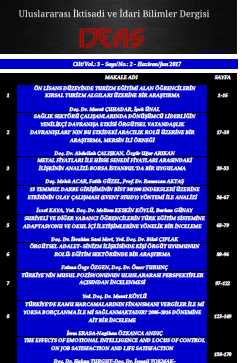FİBONACCİ ALTIN ORANINA EKONOMİK BİR YAKLAŞIM
Bu çalışmada Fibonacci altın oranın ekonomi için ne ifade edebileceği açıklanmıştır. İlk olarak Fibonacci serisinin ne olduğu ve hangi bilimlerde nasıl kullanıldığı anlatılmış daha sonra iktisat biliminde nasıl kullanılabileceği tartışılmıştır. Bunun için Solow ekonomik büyüme modelinin altın oranı ile kıyas yapılmıştır. Bu kıyası ise milli gelir muhasebesinden yola çıkılarak basit Keynes harcama denklemi kullanılmıştır. Böylece milli gelirin ne kadarının tüketime ne kadarının tasarrufa ayrılması gerektiği Fibonacci altın oranıyla belirlenmiştir. Bu mukayeseyi yapmak için Solow büyüme modeli altın oranı matematiksel olarak açıklanarak Fibonacci altın oranına olan benzerliği anlatılmıştır. Bu benzerlik ise Solow modelinin ekonmometrik analizi ile Fibonacci oranına yakınsadığı ispatlanmıştır. Ekonometrik analiz 22 OECD ülkesinin verileri kullanılarak panel veri yöntemi kullanılarak yapılmıştır. Sonuç olarak Fibonacci altın oranının diğer bilimlerde olduğu gibi sosyal bir bilim olan iktisatta da bir yer edinebileceği vurgulanmıştır.
Anahtar Kelimeler:
Fibonacci Altın Oranı, Solow Altın Oranı, Panel Veri Analizi
AN ECONOMİC APPROACH TO FİBONACCİ GOLD RATİO
In this study, it is explained what the Fibonacci gold ratio can mean for the economy. Firstly, what is the Fibonacci series and how it is used in science is explained. Then how to use it in economics. For this, the economic growth model of Solow is compared with Fibonacci. This coastline is based on simple income accounting and simple Keynes expenditure equation is used. Thus, how much of national income should be allocated between consumption and saving is determined by Fibonacci gold ratio. To do this, the Solow growth model's gold ratio is mathematically explained to describe the similarity to the Fibonacci gold ratio. This similarity proves via econometric analysis that the Solow model converges to Fibonacci ratio. Econometric analysis was analyzed by panel data method using data from 22 OECD countries. As a result, it is emphasized that Fibonacci gold ratio can be a place in economics which is a social science as in other sciences.
Keywords:
Fibonacci Gold Ratio, Solow Gold Ratio, Panel Data Analysis,
___
- 1. Barro, Robert ve Sala-i Martin, Xavier 2004. Economic Growth, MIT Press, Second2. Barro, R.J. 1991. Economic Growth in a Cross Section of Countries, The Quarterly Journal of Economics, 106(2): 407-43.3. Eruygur, Ozan 2011. Growth Theories, Lecture Notes 12, Ankara4. Inada, Ken-Ichi. 1963. On a Two-Sector Model of Economic Growth: Comments and a Generlization. Review of Economic Studies, 30, June, 119-1275. Mankiw, N. G., D. Romer, and David N. Weil. 1992. A Contribution to the Empirics of Economic Growth. Quarterly Journal of Economics, 107(2): 407-437. Massaschusetts Institute of Technology Press.6. Pazarlıoğlu, .M. V. 2001. 1980-1990 DönemindeTürkiye’de İç Göç Üzerine Ekonometrik Model Çalışması, V.Ulusal Ekonometri Ve İstatistik Sempozyumu, 19-22 Eylül2001, Adana 7. Solow, Robert M. 1956. A Contribution to the Theory of Economic Growth, MIT Press, The Quarterly Journal of Economics, Vol. 70, No. 1 8. Stock, James H. and Watson, Mark W. 2011. Introduction to Econometrics, Pearson.9. Verbeek, M. 2004. A Guide to Modern Econometrics. 2nd Edition, Erasmus University Rotterdam, John Wiley & Sons Ltd., Hoboken.10. https://data.worldbank.org11. https://www.gcmforex.com/egitim/teknik-analiz/fibonacci/
- ISSN: 2149-5823
- Başlangıç: 2015
- Yayıncı: Ömer TURUNÇ
